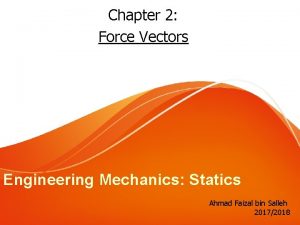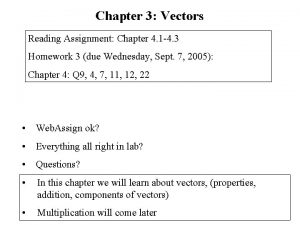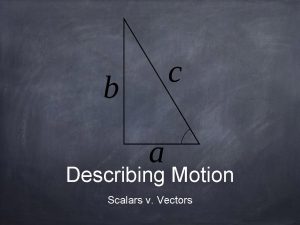Chapter 3 Section 1 Introduction to Vectors Scalars












- Slides: 12

Chapter 3 Section 1 Introduction to Vectors Scalars and Vectors • A scalar is a physical quantity that has magnitude but no direction. – Examples: speed, volume, the number of pages in your textbook • A vector is a physical quantity that has both magnitude and direction. – Examples: displacement, velocity, acceleration - The length of the arrow describes the magnitude of the vector & the direction of the arrow indicates the direction of the vector Chapter menu Resources Copyright © by Holt, Rinehart and Winston. All rights reserved.

Chapter 3 Section 1 Introduction to Vectors Graphical Addition of Vectors: Chapter menu Resources Copyright © by Holt, Rinehart and Winston. All rights reserved.

Chapter 3 Section 1 Introduction to Vectors Graphical Addition of Vectors • A resultant vector represents the sum of two or more vectors. • Vectors can be moved parallel to themselves in a diagram. • Draw one vector with its tail starting at the tip of the other keeping the size and direction of each vector the same. • The resultant vector is drawn from the tail of the first vector to the tip of the last vector. Chapter menu Resources Copyright © by Holt, Rinehart and Winston. All rights reserved.

Non-Collinear Vectors When 2 vectors are perpendicular, you must use the Pythagorean theorem. The hypotenuse in Physics is called the RESULTANT. Finish A man walks 95 km, East then 55 km, North. Calculate his DISPLACEMENT. 55 km, N Vertical Component Horizontal Component 95 km, E Start The LEGS of the triangle are called the COMPONENTS

BUT…. . what about the VALUE of the angle? ? ? Just putting North of East on the answer is NOT specific enough for the direction. We MUST find the VALUE of the angle. To find the value of the angle we use a Trig function called TANGENT. 109. 8 km q 55 km, N N of E 95 km, E So the COMPLETE final answer is : 109. 8 km, 30 degrees North of East

Example A bear, searching for food wanders 35 meters east then 20 meters north. Frustrated, he wanders another 12 meters west then 6 meters south. Calculate the bear's displacement. - = 12 m, W - = 6 m, S 23 m, E 14 m, N 20 m, N 35 m, E R q 14 m, N 23 m, E The Final Answer: 26. 93 m, 31. 3 degrees NORTH of EAST

Example A boat moves with a velocity of 15 m/s, N in a river which flows with a velocity of 8. 0 m/s, west. Calculate the boat's resultant velocity with respect to due north. 8. 0 m/s, W 15 m/s, N Rv q The Final Answer : 17 m/s, @ 28. 1 degrees West of North

Chapter 3 Section 2 Vector Operations Practice • Opens books to page 89 – 1, 2, 3, 4 Chapter menu Resources Copyright © by Holt, Rinehart and Winston. All rights reserved.

Chapter 3 Section 2 Vector Operations Resolving Vectors into Components Consider an airplane taking off at 95 km/h. • The hypotenuse (vplane) is the resultant vector that describes the airplane’s total velocity. • The adjacent leg represents the x component (vx), which describes the airplane’s horizontal speed. • The opposite leg represents the y component (vy), which describes the airplane’s vertical speed. Chapter menu Resources Copyright © by Holt, Rinehart and Winston. All rights reserved.

What if you are missing a component? Suppose a person walked 65 m, 25 degrees East of North. What were his horizontal and vertical components? The goal: ALWAYS MAKE A RIGHT H. C. = ? TRIANGLE! V. C = ? 25˚ 65 m

Example A plane moves with a velocity of 63. 5 m/s at 32 degrees South of East. Calculate the plane's horizontal and vertical velocity components. H. C. =? 32˚ V. C. = ? 63. 5 m/s

Chapter 3 Section 2 Vector Operations Practice • Open books to page 92 – #1 - 4 Chapter menu Resources Copyright © by Holt, Rinehart and Winston. All rights reserved.
 A storm system moves 5000 km due east
A storm system moves 5000 km due east Vector components formula
Vector components formula Different between scalar and vector quantity
Different between scalar and vector quantity Entropy is scalar or vector
Entropy is scalar or vector Multiplying or dividing vectors by scalars results in
Multiplying or dividing vectors by scalars results in Vectors form 3
Vectors form 3 Vector vs scalar quantities
Vector vs scalar quantities Extension of scalars
Extension of scalars Chapter 2: force vectors solutions
Chapter 2: force vectors solutions Chapter 3 vectors worksheets
Chapter 3 vectors worksheets Chapter 12 vectors and the geometry of space solutions
Chapter 12 vectors and the geometry of space solutions Dot product
Dot product What is the name of the quantity represented as i^?
What is the name of the quantity represented as i^?






















